Complete Guide to Fort Raleigh National Historic Site in North Carolina, including history, things to do, guided tours, hours, directions, lodging, and so much more.
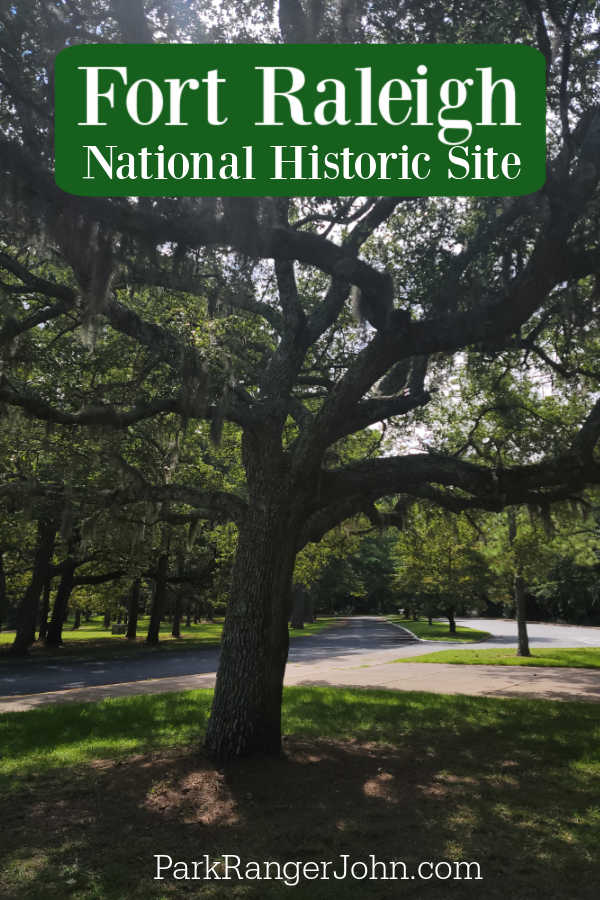
Fort Raleigh National Historic Site
Fort Raleigh National Historic Site in North Carolina protects and preserves the known portions of England's first New World Settlements that occurred from 1584 to 1590 known as the Roanoke Colony, including interpreting the story of the first two English attempts to colonize North America in the late 16th century on Roanoke Island.
This National Historic Site also preserves the cultural heritage of the Native Americans, European Americans and African Americans who have lived on Roanoke Island.
About Fort Raleigh National Historic Site
Both of these settlements were organized by famed adventurer Sir Walter Raleigh. The 1st colony was attempted in 1585 but encountered difficulties and returned to England in 1586.
The 2nd settlement attempt occurred in 1587 and also encountered issues and sent their leader John White back to England for help.
When John White left for England, he left 117 colonists, which included his granddaughter Virginia Dare. She was the first child of English parents born in the New World.
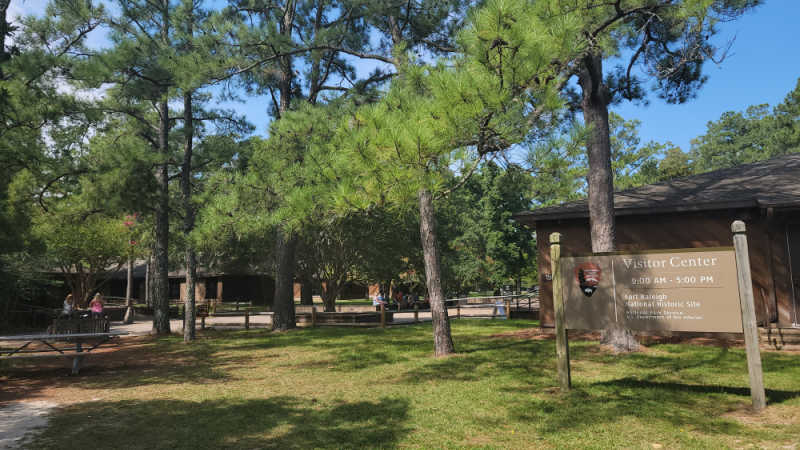
Is Fort Raleigh National Historic Site worth visiting?
Those who enjoy learning about the rich cultural and historical heritage of the United States will definitely enjoy visiting. Visitors can enjoy the park's beautiful grounds and gardens as well as the natural beauty of the area as you take in the beauty of the outdoors.
History of Fort Raleigh National Historic Site
No place is as shrouded in mystery or captures the imagination as much as Fort Raleigh National Historic Site. Fort Raleigh NHS protects the land of the first attempted British colony was established in 1587.
118 men, women, and children, settled in Roanoke in 1587. By 1890, the colony was found abandoned. No one knows what happened to the colonists.
The lost colony of Roanoke remains one of the greatest mysteries in history. The lost colony was not the only colony at Roanoke. More than 200 years after the British tried to settle in the area, the Freedman’s Colony, was established in 1862, during the American Civil War.
Fort Raleigh National Historic Site also interprets the events of the Civil War Battle of Roanoke Island in 1862. Fort Raleigh National Historic Site is part of the National Parks Service Underground Railroad Network to Freedom.
Roanoke Island, The Lost Colony
In the 1600s, Elizabethan England wanted to colonize the New World to disrupt the Spanish interest in the region. The Spanish had established trade routes along the coast of South America, the Caribbean, and Florida in North America.
The British wanted control over the trade routes that Spain was using to prosper. The British believed that by colonizing the New World, they could break the Spanish monopoly on the trade routes.
Sir Walter Raleigh ventured to the New World with two ships in 1684 to see if there was an area suitable for colonization. The expedition landed on the Outer Banks of North Carolina in July 1684. Roanoke Island was believed to be the perfect place for the first British colony in North America.
Establishing a Colony on Roanoke Island
A year after the initial scouting voyage in 1685, seven ships carrying six hundred soldiers departed from England. The soldiers would be the first colonists to settle on Roanoke Island.
After sailing through a heavy storm at sea, forcing the remaining six ships to stop in Porto Rico for repairs, the sailors finally made it to the Outer Banks in late June. Several of the vessels could not make their way inland due to their size, so they were anchored just off the Outer Banks. Terrible weather conditions damaged one of the ships, and the colonists lost most of their supplies.
The loss of supplies meant that most sailors had to return to England. 100 men stayed behind and attempted to establish a colony in Roanoke. They built a fort, houses, and defensive earthworks.
The attempt at colonization ultimately failed due to a lack of food and resources. An increasingly hostile relationship between the English colonizers and the Carolina Algonquians Native American tribes led the colonists to return to England.
Second attempt to Colonize Roanoke, 1587
In 1587 Sir Walter Raleigh sent 118 men, women, and children to establish a permanent colony in North America, somewhere in the Chesapeake Bay. Despite the plan being for the colonists to move further away from Roanoke, that is where they made their base.
John White, the leader of the expedition, believed the colonists could move northwards towards the Chesapeake by winter. White soon had to leave the newly established colony to retrieve more supplies and settlers from England.
Tensions with the Native tribes of the area, the Algonquian and Croatoan, meant they could only rely on themselves for food and resources.
White departed and instructed the settlers to divide into two groups, one to remain in Roanoke and the other to move further north to find possible sites for a new settlement. Should the colonists leave for any reason, they were to carve their destination into the trees.
It would be two years before White could return to the colony.
When White returned to the New World in 1590, he found an empty settlement. There was no sign of the 118 men, women, and children he had left behind. There was no sign of a struggle, and the colonists did not appear to have left in a hurry.
White and his men found the words CRO carved into a tree and CROATOAN carved into a fence. What happened to the colonists at Roanoke is a mystery that has stumped historians and archaeologists for centuries.
Fort Raleigh During the American Civil War
During the American Civil War, Roanoke gave the Union a foothold in North Carolina. In 1862 Roanoke was under Confederate control until the Battle of Roanoke on February 8th.
Union General Ambrose Burnside and Navy Officer Louis Goldsborough launched an attack on the Confederates occupying Roanoke Island. 20 warships and roughly 10,000 Union troops attacked the island. They began by bombarding Fort Bartow on February 7th.
On February 8th, the 10,000 Union soldiers that had landed on the island the previous day attacked the Confederate position. While Burnsides troops pursued their land attack, the Navy continued its bombardment of various targets on the island. The Confederates surrendered the island to the Union.
Freedman’s Colony
The Freedman’s Colony was established on the Union-held island in 1862. The first residents of the colony were the formerly enslaved who had been with the Confederate forces when the Union took control.
A formal colony was established by the Federal government in May 1863. The colony consisted of a church, schools, log cabin homes, and a sawmill. The colony grew to house over 3,000 formerly enslaved people.
The land on which many colonists had built their homes, was returned to the original owners after the war. By 1867, Freedman's Colony was gone.
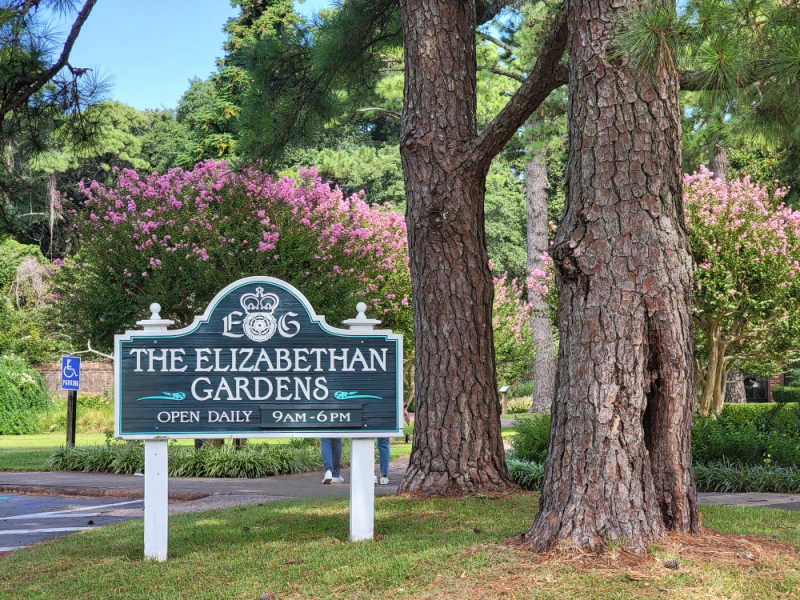
Things to know before your visit
Entrance fee
$0.00, there are no fees to visit this park
Learn more about National Park Passes for parks that have an entrance fee.
$80.00 - For the America the Beautiful/National Park Pass. The pass covers entrance fees to all US National Park Sites and over 2,000 Federal Recreation Fee Sites for an entire year and covers everyone in the car for per-vehicle sites and up to 4 adults for per-person sites.

Buy your pass at this link, and REI will donate 10% of pass proceeds to the National Forest Foundation, National Park Foundation, and the U.S. Endowment for Forestry & Communities.
National Park Free Entrance Days -Mark your calendars with the five free entrance days the National Park Service offers annually.
Time Zone
Eastern Time Zone
Pets
Pets must be on a leash no longer than 6' at all times. Pets are not allowed in buildings.
Cell Service
The quality of cellular service within the park is usually good.
Park Hours
The park grounds are open 24 hours a day all year. The visitor center hours are 9:00 AM to 5:00 PM daily, closed on Christmas Day.
Wi-Fi
There is a public Wi-Fi available.
Insect Repellent
Insect repellent is always a great idea when outdoors, especially if you are around any body of water.
We use Permethrin Spray on our clothes before our park trips.
Water Bottle
Make sure to bring your own water bottle and plenty of water with you. Plastic water bottles are not sold in the park.
Parking
There is a large parking area near the visitor center.
Food/Restaurants
There are no restaurants within the park.
Gas
There are no gas stations within the park.
Drones
Drones are not permitted within National Park Sites.
National Park Passport Stamps
National Park Passport stamps can be found in the visitor center.
We like to use these circle stickers for park stamps so we don't have to bring our passport book with us on every trip.
The National Park Passport Book program is a great way to document all of the parks you have visitied.
You can get Passport Stickers and Annual Stamp Sets to help enhance your Passport Book.
Electric Vehicle Charging
There are 3 electric vehicle (EV) charging stations within a 10-mile radius of the center of Manteo, NC.
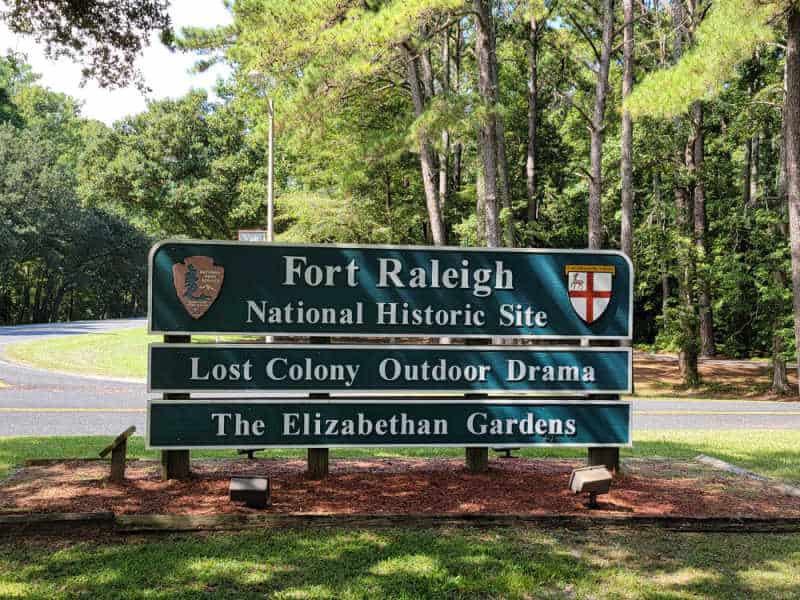
Details about Fort Raleigh National Historic Site
Size - 355.45 acres
Check out how the park compares to other National Parks by Size.
Date Established
April 5, 1941
Visitation
In 2021, Fort Raleigh NHS had 293,447 park visitors.
In 2020, Fort Raleigh NHS had 153,519 park visitors.
In 2019, Fort Raleigh NHS had 248,139 park visitors.
Learn more about the most visited and least visited National Parks in the US
National Park Address
1500 Fort Raleigh Road, Manteo, NC 27954
Located on the northern end of Roanoke Island, north of the town of Manteo, NC.
National Park Map
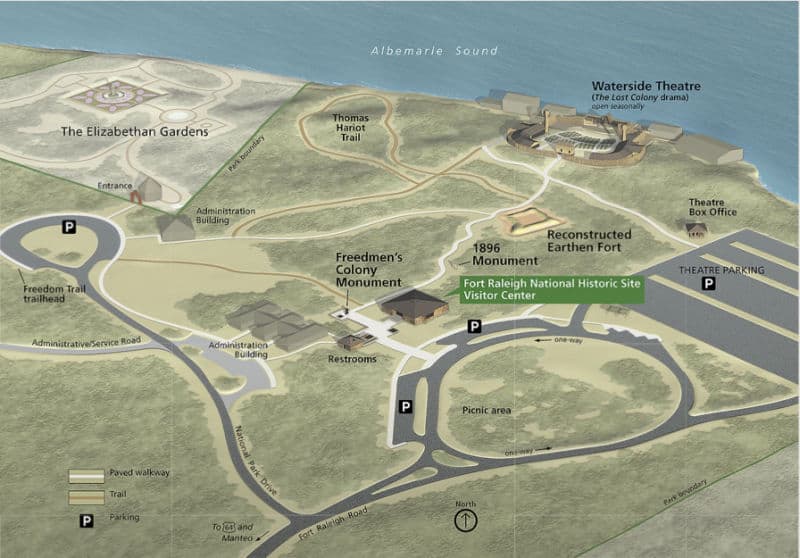
Where is Fort Raleigh National Historic Site?
Fort Raleigh National Historic Site is located on the north end of Roanoke Island, north of the town of Manteo, NC.
Part of the Outer Banks barrier islands.
Estimated distance from major cities nearby
- Chesapeake, VA - 100 miles
- Virginia Beach, VA - 108 miles
- Raleigh, NC - 190 miles
- Durham, NC - 215 miles
- Washington, DC - 290 miles
- Greensboro, NC - 285 miles
- Baltimore, MD - 335 miles
- Philadelphia, PA - 430 miles
- Newark, NJ - 450 miles
Estimated Distance from nearby National Park
Shenandoah National Park - 280 miles
New River Gorge National Park - 439 miles
Congaree National Park - 395 miles
Mammoth Cave National Park - 735 miles
Great Smoky Mountains National Park - 469 miles
Where is the National Park Visitor Center?
The visitors center is very easy to find with signs directing to the parking area.
Getting to Fort Raleigh National Historic Site
Closest Airports
Dare County Regional Airport (MQI)
International Airports
Norfolk International Airport (ORF/KORF)
Newport News/Williamsburg International Airport
Richmond International Airport (RIC)
Regional Airports
Elizabeth City Regional Airport (ECG)
Coastal Carolina Regional Airport (EWN)
Driving Directions
North (From Norfolk, VA)
Follow I-95 South to Richmond, Virginia. Take I-64 East toward Norfolk/ Virginia Beach, Virginia. Take I-64 or I-664 to Chesapeake, Virginia. From I-64, take Exit 291B to Route 168, the Chesapeake Expressway*. Once in North Carolina, Route 168 turns into US 158 East. Follow US 158 through Kitty Hawk, Kill Devil Hills, and Nags Head, North Carolina. At Whalebone Junction (where State Highway 12 heads down Cape Hatteras National Seashore), follow the main road as it curves to the west and turns into US 64. Follow US 64 to Roanoke Island. On Roanoke Island, turn north at the intersection to go toward Manteo, North Carolina on US 64/264. Follow US 64/264 through the town of Manteo, North Carolina to the northern end of the island, where you will see the entrance sign to Fort Raleigh National Historic Site.
West (From Rocky Mount, NC)
Via I-95 into North Carolina. Take US 64 East toward Rocky Mount. Follow US 64 east through Williamston and Plymouth, North Carolina. From Plymouth, continue east to Roanoke Island. On Roanoke Island, turn north at the intersection to go toward Manteo, North Carolina on US 64/264. Follow US 64/264 through the town of Manteo, North Carolina to the northern end of the island, where you will see the entrance sign to Fort Raleigh National Historic Site.
South (From Florence, SC)
Coming from South Carolina, take I-95 to Wilson, North Carolina. Take 264 East through Greenville and Washington. From Washington, take State Route 32 to Plymouth, and follow US 64 East to Roanoke Island. On Roanoke Island, turn north at the intersection to go toward Manteo, North Carolina on US 64/264. Follow US 64/264 through the town of Manteo, North Carolina to the northern end of the island, where you will see the entrance sign to Fort Raleigh National Historic Site.

Best time to visit Fort Raleigh National Historic Site
You may visit Fort Raleigh National Historic Site anytime you want to, but it’s best to visit during the spring or fall seasons because the weather is generally mild and comfortable during these times.
The temperatures are not too hot or too cold, making it the perfect time to explore the outdoor exhibits and trails at the site.
Weather and Seasons
The warmest weather is from June 3rd to September 18th, with an average daily high temperature above 79 degrees.
The cool weather is from December 5th to March 13th, with an average daily high temperature below 58 degrees.
The coldest month is January, with an average low of 38 degrees and a high of 52 degrees.
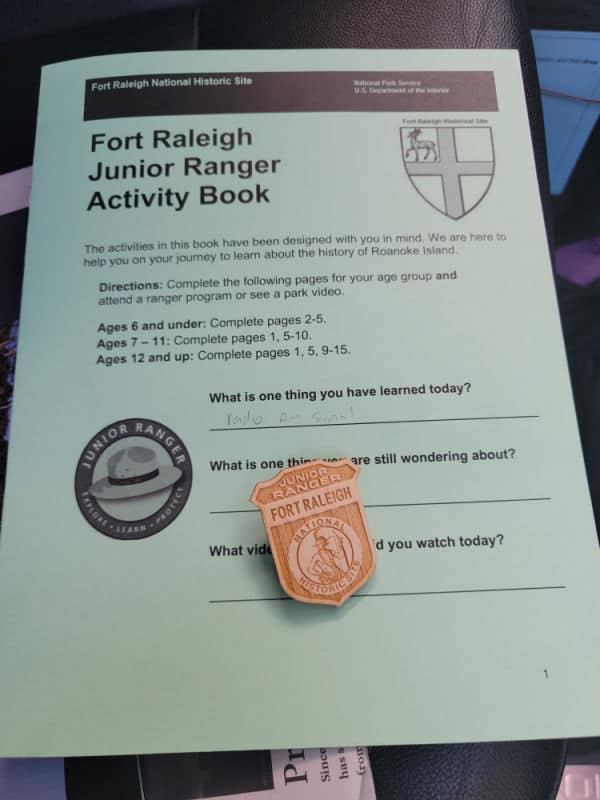
Best Things to do in Fort Raleigh National Historic Site
We suggest planning a minimum of an hour or two to visit the park. If you plan to hike or enjoy a Ranger program please prepare for a longer visit.
Lindsay Warren Visitor Center
The visitor center included amazing interpretive displays exhibits on the Algonquian, the English, the Roanoke Island Freedmen's Colony, the Civil War Battle of Roanoke Island, and Reginald Fessenden, the parks short film, and the Raleigh Room.
There are fantastic interpretive displays including learning about early radio experiments, the first English settlement, Fort Raleigh Site, and the amazing Elizabethan room.
Plan time to wander in the Elizabethan Room and stare in wonder at the ornate ceiling and wood paneling.
Check out the beautiful crepe myrtle trees that bloom for 100 days during the summer in amazing pinks and purples.
Junior Ranger Program
The Junior Ranger Program can be picked up at the visitor center front desk or you can prepare for your trip by downloading the Junior Ranger booklet before your trip begins.
This booklet is mainly filled out within the visitor center. It is great for learning more about the park and the history of the area.
1896 Monument
This stone marker commemorates the birth of Virginia Dare, the first English child born in North America along with the baptism of a Croatoan native Manteo.
First Light of Freedom
The First Light of Freedom monument commemorates the Roanoke Island Freedman's Colony that was set up during American Civil War.
Earthwork
There is archeological evidence of an earthwork that could be the workshop site of Joachim Gans, a metal expert on the 1585 expedition. The earthwork seen today was reconstructed in 1950.
Waterside Theater
The nation's first and longest-running outdoor symphonic drama The Lost Colony is performed by the Roanoke Island Historical Association at the Waterside Theatre.
The outdoor symphonic drama is performed evenings from late May to mid-August.
First staged in 1937, The Lost Colony is the nation’s premier and longest-running outdoor symphonic drama.
North Carolina playwright Paul Green wrote the production with a combination of drama, song, and dance.
Franklin D. Roosevelt attended the play on August 18. 1937. Some of the famous actors that have been part of the production include Andy Griffith, Terrence Mann, and William Ivey Long.
Elizabethan Gardens
The Elizabethan Gardens provide the opportunity to enjoy 10 acres of flora designed as a living memorial to England's first " New World" colonists.
Tickets are $10 for adults age 18 and older
Hiking in Fort Raleigh National Historic Site
Always carry the 10 essentials for outdoor survival when exploring.
Freedom Trail
The Freedom Trail is a 1.25-mile trail that ends with views of Croatan Sound located on the western edge of the park.
Thomas Harriot Trail
The Thomas Hariot Nature Trail is a .3 mile loop trail that runs through the maritime forest before reaching the sandy shores of Albemarle Sound.
The maritime forest is dominated by trees that stay green all year long. Trees you may see along the nature trail include Live Oak, Laurel Oak, and Loblolly Pine.
Native plants include Virginia Creeper, Grapevines, Sassafras, Moundlily yucca, Yaupon holly, American Holly, and more.
There are wayside exhibits along the trail that explain what the English observed of the New World's natural resources.
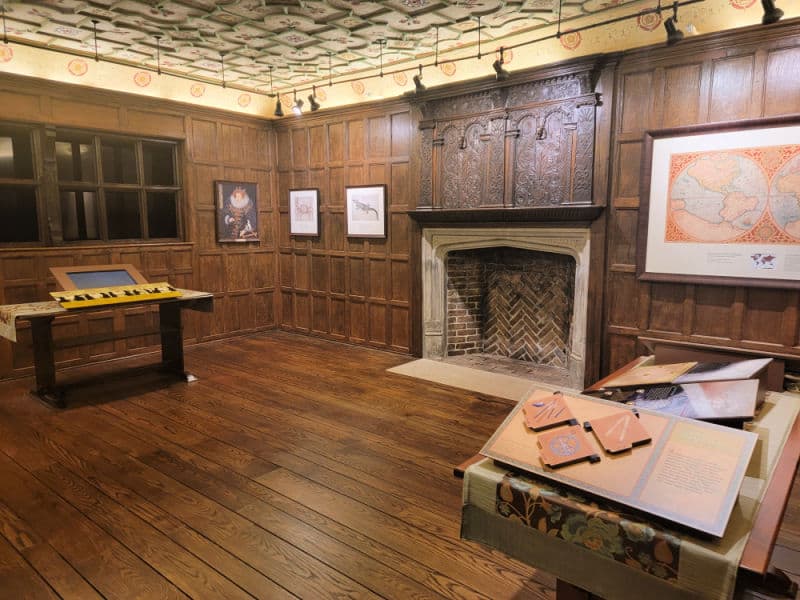
How to beat the crowds?
We did not experience any crowds while visiting the park. The visitor center is nicely sized making it easy to move around people or groups.
Where to stay when visiting Fort Raleigh National Historic Site
There are no National Park Lodges within the park.
Elizabethan Inn - Hotel in the historic district. Elizabethan Inn has a terrace, a bar, and a gym. Free in-room Wi-Fi is available to all guests, along with a business center and a restaurant.
Island Guesthouse and Motel - Island Guesthouse and Motel provide everything you need. Stay connected with free in-room Wi-Fi.
Cameron House Inn - 4-star guesthouse in a shopping district. You can look forward to a terrace, a garden, and conference space at Cameron House Inn. Stay connected with free in-room Wi-Fi.
White Doe Inn - 4.5-star bed & breakfast in a shopping district. Take advantage of free full breakfast, a terrace, and a garden at White Doe Inn. Treat yourself to a hot stone massage or other spa services. The onsite American cuisine restaurant, Lite Fare Dining, features garden views and brunch. Free in-room Wi-Fi is available to all guests, along with a library and a fireplace in the lobby.
Roanoke Island Inn - 3.5-star bed & breakfast. Consider a stay at Roanoke Island Inn and take advantage of free continental breakfast, a garden, and a snack bar/deli. Guests can connect to free in-room Wi-Fi.
Click on the map below to see additional nearby lodging and vacation rentals.
Outer Banks Camping
Campgrounds are located approximately 30 minutes drive from the park. The nearest National Park-operated campground is at Oregon Inlet Campground.

For a fun adventure check out Escape Campervans. These campervans have built in beds, kitchen area with refrigerators, and more. You can have them fully set up with kitchen supplies, bedding, and other fun extras. They are painted with epic designs you can't miss!
Escape Campervans has offices in Vancouver, Seattle, Portland, San Francisco, Las Vegas, Los Angeles, Phoenix, Salt Lake City, Denver, New York, and Orlando

Parks Near Fort Raleigh National Historic Site
Wright Brothers National Memorial
Cape Hatteras National Seashore
Cape Lookout National Seashore
Colonial National Historical Park
Richmond National Battlefield Park
Check out all of the North Carolina National Parks along with neighboring National Parks in South Carolina, Tennessee National Parks, Virginia National Parks, and National Parks in Georgia
Check out all of the US National Historic Sites managed by the NPS
Make sure to follow Park Ranger John on Facebook, Instagram, Pinterest, and TikTok





Leave a Reply